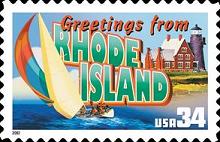 In an earlier conversation with Lefty over at A View From Battleship Cove, we discussed the fateful day in the nineteenth century where sections of modern day Fall River north of Tiverton, RI were ceded to Massachusetts from Rhode Island in exchange for land that eventually formed present day East Providence, as well as the city of Pawtucket east of the Blackstone River. Sounds simple, right?
In an earlier conversation with Lefty over at A View From Battleship Cove, we discussed the fateful day in the nineteenth century where sections of modern day Fall River north of Tiverton, RI were ceded to Massachusetts from Rhode Island in exchange for land that eventually formed present day East Providence, as well as the city of Pawtucket east of the Blackstone River. Sounds simple, right?Wrong. As it turns out, there may not be another state in the union that has had to define and defend its borders as much as Rhode Island. In fact, the entire history of the state (including the present day) has been one of border disputes with Connecticut, Massachusetts, and even New York. This is the first part in what I hope will become a series getting to the bottom of Rhode Island's messy territorial disputes with her neighbors. While Lefty handles it from the Massachusetts side, I'll be taking a look from the Rhode Island side.
Let's start from the beginning.
In 1638, Roger Williams finalized the deed honoring the purchase of the Providence Plantations from the Narragansett sachems. By 1642, Williams' original purchases were merged with the newly founded Warwick settlement, and the towns of Portsmouth and Newport on Aquidneck island ("Rhode Island") to create a charter colony uniting the four towns, thereby creating a union between Rhode Island and the Providence Plantations.
By 1643, neighboring the neighboring Plymouth Colony, already annoyed by Williams' perceived assault on the right of Puritans to establish a theocracy, begin staking a claim to land in the nascent Rhode Island and Providence Plantations colony. To prevent ceding his gains to the Puritan colony, Roger Williams hastily sailed to England, secured a land patent from the English parliament in 1644 to preserve the union of Rhode Island and Providence Plantations. Williams' accomplishment, secured with Parliament during the English Civil War, was secured again after the Stuart Restoration of 1660, whereupon Williams' "lively experiment" with religious tolerance in New England was set on firm legal ground with a new royal charter that set the tiny colony on an equal footing with other British colonies in North America.
After 1660, settlement in the remainder of the Providence Plantations west of Narragansett Bay expanded, and neighboring colonies began to engage Rhode Island and Providence Plantations in a series of continual border disputes, with Connecticut on the west, and Massachusetts and Plymouth colonies on the north and east.
I'm going to hit the books and the web to see where the first important territorial disputes where handled, what land they involved, and how the disputes were settled (and in whose favor) for my next update on this. As always, anyone with any information they'd like to add should just leave me a comment.
UPDATE: Dictators Of The World has more updates than you can shake a kangaroo court at!




3 comments:
Oh my, it looks like Wilmington, NC...just a clutter.
I am so SORRY....
The Supreme Court of the U.S had three different cases between Massachusetts adn Rhode Island in the 1800s -- all on territorial disputes.
I'm from the beautiful southern state of North Carolina!! I just love your beautiful state of Rhode Island!! It is one of my favorite of all the 50 states and D.C.!!
Post a Comment